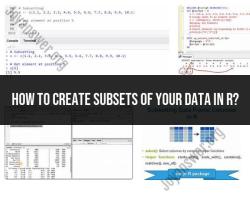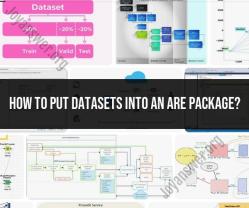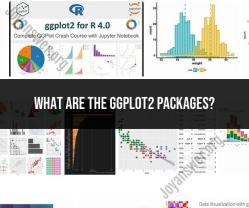How to create subsets of your data in R?
Creating subsets in R involves extracting specific portions or segments of your data based on certain criteria. Here are several ways to create subsets efficiently:
Using Subset Functions:
Subsetting Rows Based on Conditions:
- Use the
subset()function to extract rows from a data frame based on specified conditions.
Rsubset(df, condition)Example:
Rsubset(my_data, age > 30 & gender == "Male")- Use the
Indexing Rows and Columns:
- Use square brackets
[ ]to subset rows and columns by specifying row indices and column names or indices.
Rdata_subset <- data[row_indices, column_indices]Example:
Rsubset <- my_data[my_data$age > 30 & my_data$gender == "Male", c("name", "age")]- Use square brackets
Using dplyr Package:
- The
dplyrpackage offers a more intuitive way to filter data usingfilter()function and select specific columns usingselect()function.
Rlibrary(dplyr) filtered_data <- filter(df, condition) selected_columns <- select(df, column_names)Example:
Rfiltered_data <- filter(my_data, age > 30, gender == "Male") selected_cols <- select(my_data, name, age)- The
Sampling Rows:
- Use
sample_n()orsample_frac()from thedplyrpackage to randomly sample a specific number of rows or a fraction of the data.
Rsampled_data <- sample_n(df, n) sampled_frac_data <- sample_frac(df, fraction)Example:
Rsampled_data <- sample_n(my_data, 100) sampled_frac_data <- sample_frac(my_data, 0.1)- Use
Subsetting by Grouping:
Split-Apply-Combine:
- Use functions like
split(),lapply(),sapply(), ortapply()to segment data by groups and perform operations within each group.
Rsplit_data <- split(df, df$group_column) lapply(split_data, function(x) your_operation(x))- Use functions like
Using the
group_by()andsummarize()Functions (dplyr):- These functions allow for grouping data by specific variables and summarizing within each group.
Rgrouped_data <- group_by(df, group_column) summarise(grouped_data, mean_value = mean(numeric_column))
Choose the method that best suits your data and analysis needs. The dplyr package is highly efficient for data manipulation and subset creation in R, especially for larger datasets and complex operations.
What procedures can be employed in R to generate subsets of your data?
There are several ways to generate subsets of your data in R, depending on your specific needs and the structure of your data. Here are some of the most common procedures:
1. Subsetting with square brackets:
- This is the most basic approach and allows you to subset data based on row and column indices.
- Syntax:
data[rows, columns] - Example:
data[1:10, 2:4]selects rows 1 to 10 and columns 2 to 4 from the data frame "data".
2. Subsetting with logical conditions:
- This method allows you to filter data based on specific conditions applied to one or more variables.
- Syntax:
data[condition] - Example:
data[age > 20 & income > 50000]selects rows where the "age" is greater than 20 and the "income" is greater than 50000.
3. Subsetting with functions:
- Several built-in functions in R can be used for subsetting data based on specific criteria.
- Common functions:
subset(),filter(),which(),dplyr::filter(),dplyr::slice() - Example:
subset(data, age > 20 & income > 50000)
4. Subsetting with missing values:
- You can use specific operators to handle missing values when subsetting data.
- Operators:
is.na(),!is.na(),%in%,%nin% - Example:
data[!is.na(age) & income > 50000]selects rows where "age" is not missing and "income" is greater than 50000.
5. Advanced subsetting techniques:
- For more complex data exploration and manipulation, you can utilize advanced techniques like nested subsets, subsetting with regular expressions, and manipulating data frames with functions like
lapply()andsapply().
Here are some additional tips for subsetting data in R:
- Use clear and descriptive variable names and column names to improve the readability of your code.
- Document your subsetting steps and rationale for creating specific subsets.
- Test your subsets to ensure they are capturing the desired data correctly.
- Leverage the power of functions and packages like dplyr to simplify and improve the efficiency of your subsetting tasks.
By mastering these procedures and best practices, you can efficiently generate meaningful subsets of your data in R, enabling you to perform deeper analysis and draw valuable insights.





